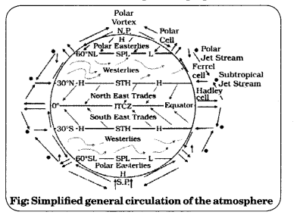1. Multiple choice questions.
Question 1(i).
If the surface air pressure is 1,000 mb, the air pressure at 1 km above the surface will be:
(a) 700 mb
(b) 1,100 mb
(c) 900 mb
(d) 1,300 mb.
Answer:
(c) 900 mb
Question 1(ii).
The Inter Tropical Convergence Zone normally occurs:
(a) Near the Equator
(b) Near the Tropic of Cancer
(c) Near the Tropic of Capricorn
(d) Near the Arctic Circle.
Answer:
(a) Near the Equator
Question 1(iii).
The direction of wind around a low pressure in northern hemisphere is:
(a) Clockwise
(b) Perpendicular to isobars
(c) Anti-clock wise
(d) Parallel to isobars.
Answer:
(c) Anti clock wise
Question 1(iv).
Which one of the following is the source region for the formation of air masses?
(a) The Equatorial Forest
(b) The Himalayas
(c) The Siberian Plain
(d) The Deccan Plateau.
Answer:
(c) The Siberian plains.
2. Answer the following questions in about 30 words.
Question 2(i).
What is the unit used in measuring pressure? Why is the pressure measured at station level reduced to the sea level in preparation of weather maps?
Answer:
Millibar or Pascal is the unit for measuring pressure. Most widely used unit is kilo Pascal expressed as hpa. Horizontal distribution of pressure is studied by drawing isobars at constant levels. Isobars are lines connecting places having equal pressure. In order to eliminate the effect of altitude on pressure, it is measured at any station after being reduced to sea level for making it comparative. The pressure measured at station level is reduced to the sea level in preparation of weather maps.
Question 2(ii).
While the pressure gradient force is from north to south, i.e. from the subtropical high pressure to the equator in the northern hemisphere, why are the winds north easterlies in the tropics?
Answer:
Rotation of the earth also affects the wind movement. The force exerted by the rotation of the earth is known as the Coriolis force. Due to this effect, winds move to the right from their original direction in northern hemisphere and to the left in the southern hemisphere. The deflection is more when the wind velocity is high. The Coriolis force is directly proportional to the angle of latitude. It is maximum at the poles and is absent at the equator. The Coriolis force acts perpendicular to the pressure gradient force.
The pressure gradient force is perpendicular to an isobar. The higher the pressure gradient force, the more is the velocity of the wind and the larger is the deflection in the direction of wind. As a result of these two forces operating perpendicular to each other, in the low-pressure areas the wind blows around it. Therefore, when pressure gradient force is from south to north then winds move from south to north easterlies.
Question 2(iii).
What are the geotrophic winds?
Answer:
The velocity and direction of the
wind are the net result of the wind generating forces. The winds in the upper atmosphere, 2-3 km above the surface, are free from frictional effect of the surface and are controlled mainly by the pressure gradient and the Coriolis force. When isobars are straight and when there is no friction, the pressure gradient force is balanced by the Coriolis force and the resultant wind blows parallel to the isobar. This wind is known as the geostrophic wind.
Question 2(iv).
Explain the land and sea breezes.
Answer:
During the day the land heats up faster and becomes warmer than the sea. Therefore, over the land the air rises giving rise to a low pressure area, whereas the sea is relatively cool and the pressure over sea is relatively high.
Thus, pressure gradient from sea to land is created and the wind blows from the sea to the land which is known as sea breeze. In the night the reversal of condition takes place. The land loses heat faster and is cooler than the sea.
The pressure gradient is from the land to the sea. This breeze is known as land breeze.
3. Answer the following questions in about 150 words.
Question 3(i).
Discuss the factors affecting the speed and direction of wind.
Answer:
Air is set in motion due to the differences in atmospheric pressure. The air inmotion is called wind, which blows from high pressure to low pressure. The wind at the surface experiences friction. In addition, rotation of the earth also affects the wind movement. The force exerted by the rotation of the earth is known as the Coriolis force. Thus, the horizontal winds near the earth surface respond to the combined effect of three forces — the pressure gradient force, the frictional force and the Coriolis force. In addition, the gravitational force acts downward.
1.Pressure gradient force:Thedifferences in atmospheric pressure produce a force. The rate of change of pressure with respect to distance is the pressure gradient. The pressure gradient is strong where the isobars are close to each other and is weak where the isobars are apart.
2. Frictional force:It affects the speed of the wind. It is greatest at the surface and its influence generally extends upto an elevation of 1 – 3 km. Over the sea surface the friction is minimal.
3.Coriolis force:The rotation of the earth about its axis affects the direction of the wind. This force is called the Coriolis force. It deflects the wind to the right direction in the northern hemisphere and in nature. They oscillate with the apparent movement of the sun. In the northern hemisphere in winter they move southwards and in the summer northwards.
Question 3(ii).
Draw a simplified diagram to show the general circulation of the atmosphere over the globe. What are the possible reasons for the formation of subtropical high pressure over 30° N and S latitudes?
Answer:
The general circulation of the atmosphere also sets in motion the ocean water circulation which influences the earth’s climate. The general circulation of the atmosphere also affects the oceans. The large-scale winds of the atmosphere initiate large and slow moving currents of the ocean, which in turn provide input of energy and water vapour into the air.
These interactions take place rather slowly over a large part of the ocean. The air at the Inter Tropical Convergence Zone (ITCZ) rises because of convection caused by high insolation and a low pressure is created. The winds from the tropics converge at this low pressure zone. The converged air rises along with the convective cell. It reaches the top of the troposphere up to an altitude of 14 km. and moves towards the poles. This causes accumulation of air at about 30° N and S. Part of the accumulated air sinks to the ground and forms a subtropical high. Another reason . for sinking is the cooling of air when it reaches 30° N and S latitudes.





